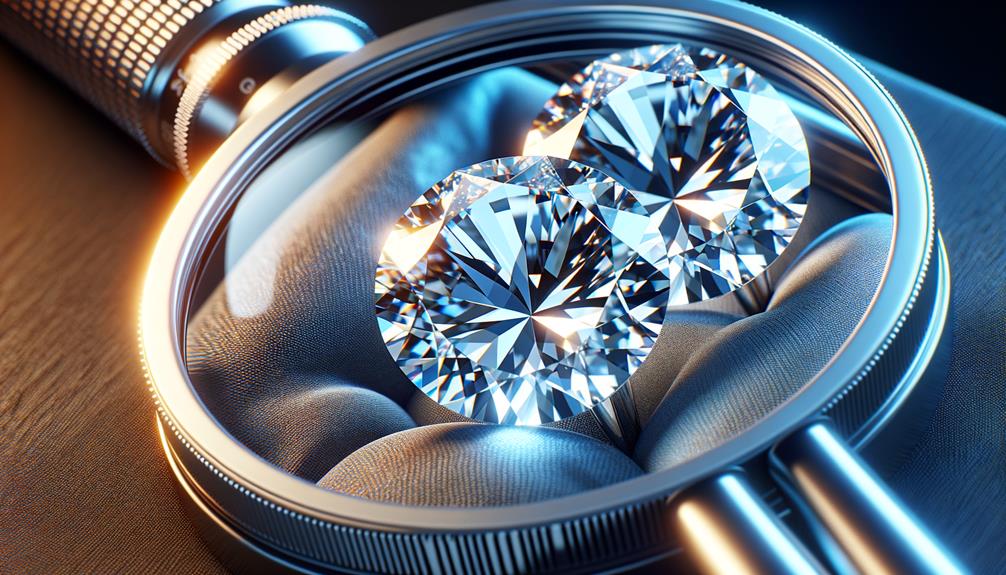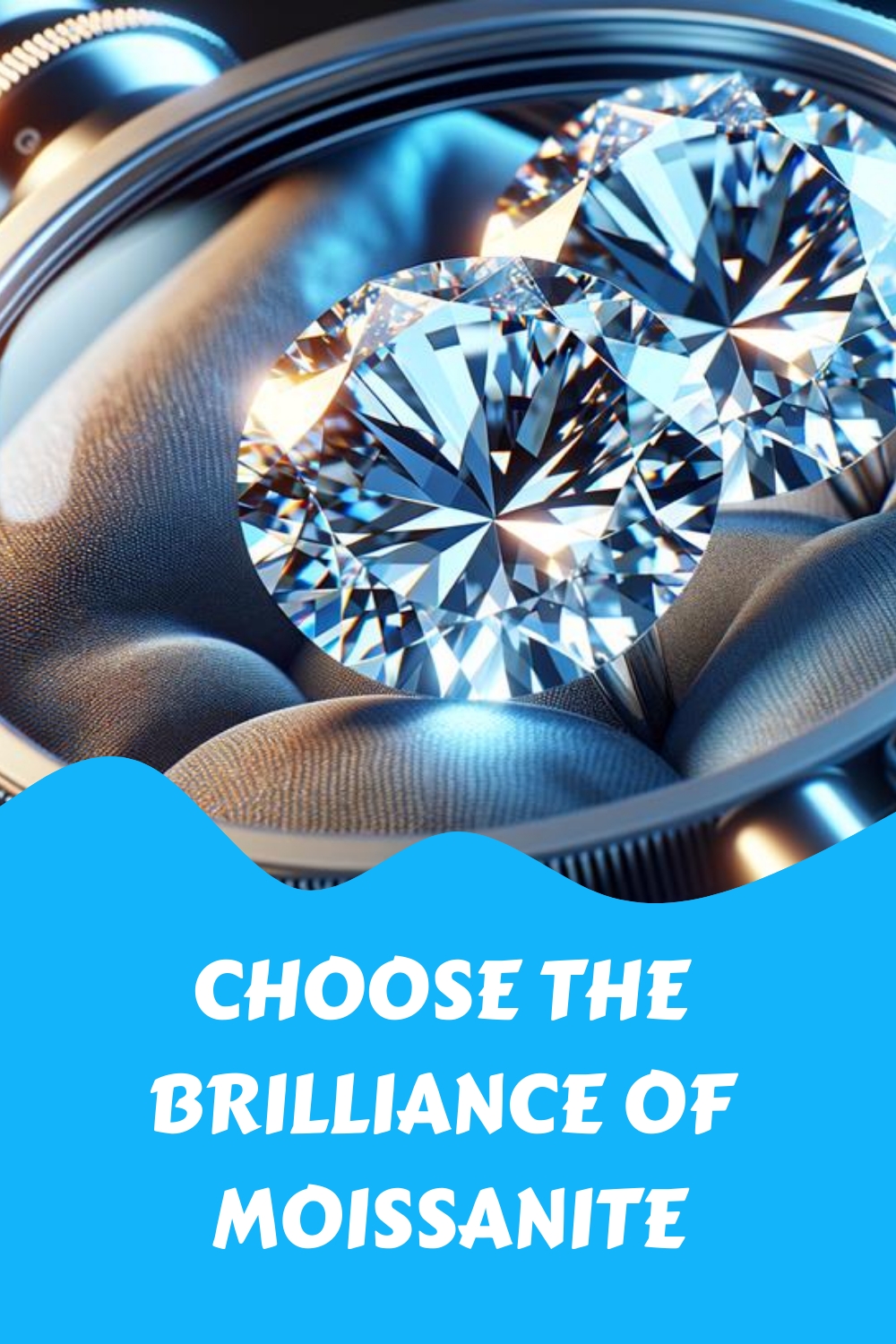Doubling down on moissanite signifies a conscious shift towards affordable luxury and ethical consumption in the jewelry industry. As a lab-created gemstone, moissanite offers a high refractive index, making it a brilliant alternative to diamonds at a fraction of the cost. With a robust score of 9.25 on the Mohs scale, its durability matches its beauty, making it suitable for everyday wear. Importantly, moissanite’s lab-grown origins promote ethical sourcing, minimizing environmental impact and fostering social responsibility. Whether through custom designs or informed investments guided by quality certifications, consumers increasingly recognise moissanite’s value. Exploring this option further will uncover a world where luxury and ethics harmoniously coexist.
Article Contents
Key Takeaways
- Moissanite offers a cost-effective, high-quality alternative to diamonds, making it an attractive investment.
- Lab-grown origins ensure ethical sourcing, reducing environmental impact and supporting ethical labour practices.
- With a Mohs scale rating of 9.25, moissanite is durable and ideal for daily wear, maintaining its sparkle over time.
- Certification of moissanite stones assures buyers of their quality, authenticity, and helps establish their value in the market.
- Customizing moissanite jewellery allows for unique, personalized designs that stand out, enhancing its appeal and investment value.
Moissanite Vs. Diamonds
In the world of precious stones, the comparison between moissanite and diamonds reveals significant differences in beauty, durability, cost, and ethical considerations.
Moissanite, a lab-created gemstone, shines brightly in the brilliance comparison, exhibiting a unique sparkle factor that often exceeds that of diamonds due to its higher refractive index. This characteristic guarantees that moissanite jewellery catches the eye with its dazzling display of colourful flashes, offering a distinct allure that appeals to those seeking a touch of elegance.
The price advantages of moissanite are undeniable, presenting a cost-effective alternative without sacrificing luxury. Individuals can enjoy larger, more impressive stones for a fraction of the price of diamonds, making it an attractive option for budget-conscious shoppers. The colour accuracy of moissanite further enhances its appeal, as it can mimic various diamond grades, allowing wearers to flaunt a near-colourless gem that rivals the appearance of high-quality diamonds.
Moissanite’s durability benefits, with its score of 9.25 on the Mohs scale, make it a practical choice for everyday wear. Its resistance to scratching and lack of cleavage plane contribute to its longevity, ensuring that the sparkle factor remains brilliant over time. These qualities, combined with ethical production methods, position moissanite as a cherished gemstone in the hearts of those who value beauty, sustainability, and affordability.
Grading Moissanite Stones
Understanding the differences between moissanite and diamonds sets the stage for exploring how moissanite stones are graded, focusing on their colour, clarity, and overall quality. This grading is pivotal in establishing moissanite value, ensuring authenticity, and affirming its place in the current market trends. Additionally, it guides enthusiasts and investors towards making informed decisions about investment opportunities.
Key aspects include:
- Moissanite Colour: Ranges from colourless to nearly colourless, affecting how the stone interacts with light and its overall appearance.
- Moissanite Clarity: Involves evaluating the presence of inclusions, which can slightly influence the stone’s brilliance but are often not visible to the naked eye.
- Moissanite Certification: An essential factor that guarantees the stone’s quality, affirming its authenticity and value in the market.
Grading moissanite not only assures buyers of the quality and authenticity of their purchase but also plays a significant role in the evolving moissanite market trends. As the demand for ethical and sustainable gemstones grows, understanding these grading aspects becomes vital for anyone looking to invest in or own moissanite jewelry.
Moissanite Jewellery Purchasing Tips
When contemplating the purchase of moissanite jewelry, it is important to arm oneself with knowledge on how to select the highest quality pieces within one’s budget. Understanding the nuances of custom design can greatly enhance the personal significance and uniqueness of your moissanite piece, making it not just an accessory but a reflection of your individuality. Opting for moissanite is inherently budget-friendly, allowing for acquiring larger, more brilliant stones at a fraction of the cost of diamonds.
Familiarizing oneself with popular styles and staying informed about celebrity endorsements can also guide one’s selection process, as these factors often set the trends in the jewellery world. Whether it’s a style that graced the red carpet or a piece inspired by a celebrity’s personal collection, such endorsements can elevate the appeal and desirability of moissanite jewellery.
Moreover, considering the investment value of moissanite is vital. While it offers considerable savings upfront, its durability and timeless beauty ensure that your purchase remains a cherished part of your collection, potentially increasing in sentimental value over time. By prioritizing these key aspects, one can make a well-informed and satisfying investment in moissanite jewellery.
Ethical Considerations About Moissanite
Moissanite, with its lab-grown origins, presents a compelling ethical alternative to traditional gemstones, addressing concerns over sustainability and human rights violations. As an ethically sourced stone, moissanite supports fair labour practices and avoids the environmental degradation associated with mining. This choice reflects a growing awareness and commitment to social responsibility among consumers who seek not just beauty in their jewellery but also sustainability benefits and ethical sourcing. Furthermore, moissanite’s allure lies not only in its brilliance and durability but also in its transparency when it comes to sourcing and production, giving consumers peace of mind about their purchase. In a marketplace increasingly scrutinized for greenwashing, initiatives like the misleading ads ban on skydiamond highlight the importance of honesty in marketing, ensuring buyers are truly informed about the origins and impact of their chosen gemstones. By opting for moissanite, individuals can align their values with their purchases, championing ethical practices without compromising on aesthetic appeal.
When selecting moissanite, buyers contribute to:
- Environmental impact reduction: By avoiding mined stones, moissanite consumers greatly lower their ecological footprint, aligning with sustainability goals.
- Advocacy for better labour practices: Choosing moissanite supports industries that adhere to ethical labour standards, ensuring no child labour or underpaid work.
- Promotion of social responsibility: Opting for moissanite sends a message about the importance of ethical sourcing in jewellery, encouraging more brands to adopt responsible practices.
Longevity and Care of Moissanite
Building on its ethical appeal, the durability and care of moissanite further enhance its value as a sustainable choice in jewellery. This gemstone, ranking at a commendable 9.25 on the Mohs scale, stands just under diamonds in terms of hardness, making it an ideal candidate for daily wear without the worry of scratches or chips. However, its longevity isn’t solely dependent on its inherent resilience; regular maintenance also plays an important role.
Adopting a routine cleaning regimen is essential to guaranteeing moissanite’s everlasting sparkle. Cleaning tips include using gentle, non-abrasive cleaners to prevent any chemical exposure that could lead to temporary clouding. While moissanite is less prone to clouding than other gems, safeguarding its clarity involves minimizing its contact with harsh chemicals and dirt. Clouding prevention is, therefore, as straightforward as regular cleaning and careful handling.
Furthermore, sparkle maintenance isn’t just about preserving its visual appeal but also about ensuring the moissanite retains its value over time. Regular maintenance keeps the gemstone looking its best and strengthens its place as a cherished, sustainable choice in your jewellery collection.
Frequently Asked Questions
Is a Lab Grown Diamond the Same as Moissanite?
No, lab-grown diamonds and moissanite are not the same. They differ in chemical composition, refractive index, and appearance. While both offer durability and reduced environmental impact, their price comparison reflects these distinct characteristics and qualities.
Is Moissanite Natural or Man-Made?
Moissanite is a man-made gemstone, mirroring the crystal structure and brilliance of natural counterparts. Its origins in the lab reflect its market value and appeal in gem comparison, offering diverse jewellery options for consumers.
Conclusion
To sum up, the preference for moissanite over diamonds signifies a significant shift towards sustainability and ethical consumption in the fine jewellery market. This shift has been fueled in part by growing awareness of the environmental and ethical concerns surrounding diamond mining. Additionally, the recent De Beers divestment from the synthetic diamond market has increased the appeal of moissanite as a more responsible and affordable alternative. As a result, more consumers are choosing moissanite for engagement rings and other fine jewelry, recognizing its beauty, durability, and eco-friendly credentials. Furthermore, the rise of lab-grown moissanite has also led to increased interest in sustainable options among consumers. This, coupled with the growing trend of superdeep diamonds from responsible sources, has contributed to the changing landscape of the fine jewellery industry. As more consumers seek out eco-conscious alternatives, moissanite and superdeep diamonds are likely to continue gaining popularity in the market.
With its comparable brilliance, clarity, and fire, moissanite offers a luxurious alternative that does not compromise on quality or aesthetic appeal. With its sustainable and ethical sourcing, moissanite also aligns with the values of those who prioritize eco-friendly and responsible consumerism. Its versatility makes it a perfect choice for those who appreciate minimalist Scandinavian elegance, adding a touch of timeless sophistication to any jewelry piece. Whether set in a classic solitaire ring or a modern, geometric pendant, moissanite embodies the perfect combination of luxury and conscience.
Additionally, its synthetic origin guarantees minimal environmental impact, aligning with the growing consumer demand for responsible and conscientious choices.
Therefore, moissanite not only dazzles in its physical attributes but also shines as a beacon of ethical and sustainable luxury.



